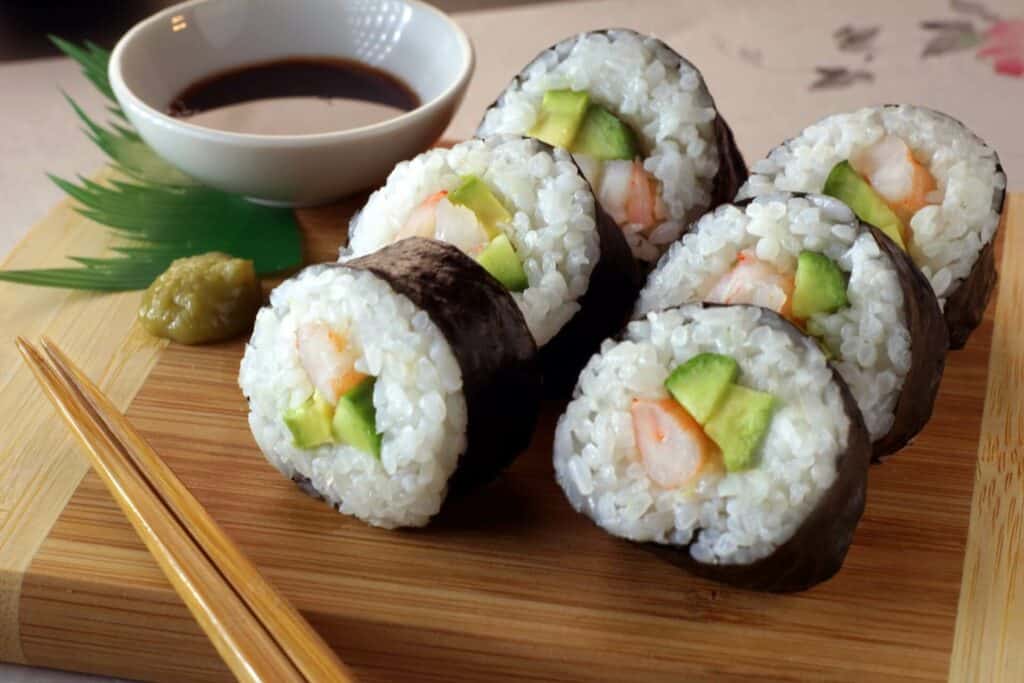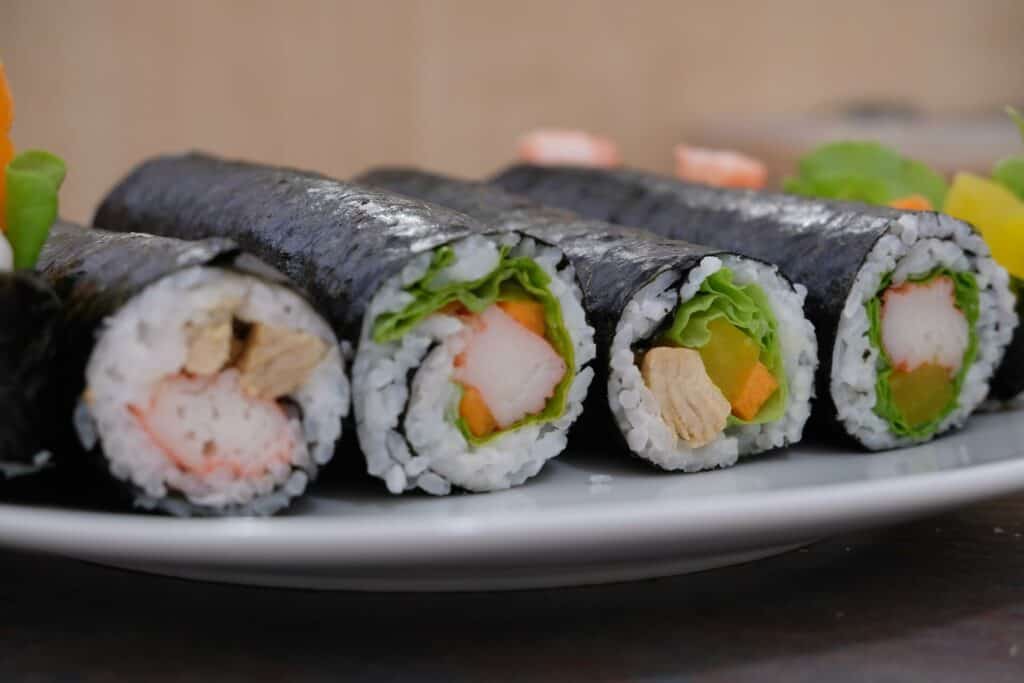When you go to a restaurant to order sushi, you’ll be asked what kind you want. If you stay baffled by the question, it means you aren’t familiar with sushi and its many types. If you’ve heard of maki, today we’ll answer the question: is maki sushi, talk more about its nutrition, and try an easy recipe.
Maki is a type of sushi roll. It’s made from the common sushi ingredients – rice, nori seaweed, tuna, salmon, and veggies, but it’s most distinctive for its look. Maki is rolled into a sheet of nori seaweed, and the first bite you take is the taste of this greenish-black, dehydrated delicacy.


If you’re just diving into the world of sushi, here’s where you’ll learn a lot about its types and taste. Visit this post if you want to know about the difference between sushi and sashimi.
What Is Maki and How Is It Different from Sushi?
Maki sushi, in Japan known as makizushi, is a type of sushi roll wrapped in a sheet of dried seaweed called nori. It was invented in old-time Tokyo, previously known as Edo. During this period, Japanese cuisine began to modernize and become established across the globe.
The inventor of makizushi was Hanaya Yohei, who, at the time, named the delicacy Edomae-zushi, by the fish he used in the rolls. The invention of this delicious type of sushi wasn’t random, though.
Dehydrated nori seaweed started taking Japan by storm and became a popular ingredient in homes and professional kitchens.
Something so simple and neat packs a punch when it comes to flavor. Nori is salty and has an umami flavor, making the taste of the rolls linger and fill the palate for a long time. If you savor a maki roll, each bite will be better than the last.
Sushi Is a Common Name for Many Types of Meals
Generally, sushi is a broad term for many kinds of food, but they’re not just any sort of meal. Some types of sushi are the following:
- Chirashi – a kind of sushi served in a rice bowl, but containing all the ingredients a roll might have,
- Inari – a portion of fried tofu with rice, named after the Shinto god of the same name,
- Maki (sometimes norimaki) – a sushi roll in a sheet of seaweed, rolled with the help of a bamboo mat; types of maki rolls are futomaki and hosomaki, or simply put, wide and thin versions,
- Nigiri – a small, oblong piece of rice covered by a piece of raw fish, shrimp, or egg,
- Gunkanmaki – a type of nigiri wrapped in nori seaweed.
After sushi arrived in the West, especially America, varieties of sushi rolls were invented and implemented in menus worldwide. The most famous are California rolls. They have rice on the outside and seaweed inside.
If you’re in the US, be sure to check out Krispy Rice.
Other sushi rolls are: tempura sushi, where the seafood is fried; inside-out sushi, where the seaweed is on the outside and rice on the inside; spider sushi, which contains soft-shell crab; and dragon sushi, which is a mix of eel and avocado.
Sushi rice is gluten free, making it a safe choice for those with celiac disease or gluten sensitivity. Sushi is also generally low in calories and fat, and is a good source of protein and omega-3 fatty acids.

Maki Rolls are Specific Because of Their Appearance
Despite the vast popularity of California rolls, maki is the supreme roll of the sushi world. Not only because it was one of the first invented, but because using seaweed in various sushi creations knows no bounds.
While it may be more attractive to see something as cool as Alaska rolls, with salmon on the outside, or a Rainbow roll with avocado wrapping, nothing compares to the classic makizushi taste.
The Nori Seaweed Gives Maki Their Taste and Looks
Nori seaweed sheets can be eaten independently. Children in Asia adore and often eat them as snacks between meals. Their looks may not be the most appealing since they’re just dried algae, but the taste makes people come back for more.
Nori is an ingredient belonging to the umami food group. Umami is one of the key tastes besides sweet, sour, salty, and bitter. It’s described as meaty, full-bodied, and special with each bite.
Nutritional Values of Nori Seaweed
Most store-bought nori packages contain ten seaweed sheets. The table below considers the nutritional value of the entire packaging.
| Nutrition | Amount | % of recommended daily intake |
| Calories | 9 | 0% |
| Total Fat | 0,1g | 0% |
| Protein | 1,5g | 3% |
| Sodium | 12mg | 1% |
| Potassium | 93mg | 3% |
| Total carbohydrates | 1,3g | 0% |
| Vitamin A | 270mcg | 27% |
| Vitamin C | 15mg | 17% |
| Calcium | 14mg | 1,4% |
| Iron | 0,2mg | 2,6% |
A Simple Recipe to Make Maki Rolls at Home
If you wish to make makizushi at home, you’re in luck – they’re incredibly easy to make. For a classic maki roll, you’ll need the following ingredients:
- 1 cup sushi rice,
- 1 cup water,
- 2 tablespoons rice or white vinegar,
- 1 tablespoon sugar,
- 1 teaspoon salt,
- 8 ounces imitation crab sticks,
- 3 sheets nori seaweed,
- 1/2 English cucumber,
- 1 avocado,
- 1 teaspoon roasted sesame seeds.
Cook the sushi rice in water for 15 minutes. Create a mix of vinegar, sugar, and salt, and warm it in the microwave until the solids are dissolved; do it in multiple, 15-second increments.
Cut the nori sheets in half, the cucumber into thin sticks, and the avocado into thin slices. Unwrap and break the crab meat with your fingers.
When the rice is cooked, mix in the vinegar mixture. Wet your hands and place the nori on a bamboo mat or some plastic wrap. Spread rice over it, and then add the rest of the ingredients.
Fold the bottom half of the roll and press to compact the rice; continue rolling until you get a nice round (or nearly round) shape. Keep trying, and don’t give up if you fail.
Cut it into smaller pieces when you’re finished rolling and enjoy your meal.
You can also eat sushi the next day.
Maki Is the Essential Sushi Roll that Delivers a Classic, Delicious Taste
You can never go wrong with maki rolls. They’re a classic, one-of-a-kind meal that shows why sushi is popular worldwide. It isn’t just a part of the sushi roll family – it’s the essential type of sushi everyone must try at least once. If you’ve never had makizushi, make sure to visit your nearest Japanese restaurant and enjoy the umami flavor.